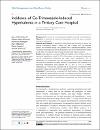Incidence of co-trimoxazole-induced hyperkalemia in a tertiary care hospital
| Author | Adawi, Rana M.Al |
| Author | Albu-Mahmood, Zainab |
| Author | Abdelgelil, Mohamed |
| Author | Abdelaziz, Hani |
| Author | Stewart, Derek |
| Author | Awaisu, Ahmed |
| Available date | 2021-04-29T10:18:08Z |
| Publication Date | 2021-01-01 |
| Publication Name | Risk Management and Healthcare Policy |
| Identifier | http://dx.doi.org/10.2147/RMHP.S283471 |
| Citation | Al AdAwi RM, Albu-Mahmood Z, Abdelgelil M, Abdelaziz H, Stewart D, Awaisu A. Incidence of Co-Trimoxazole-Induced Hyperkalemia in a Tertiary Care Hospital. Risk Manag Healthc Policy. 2021;14:519-525 https://doi.org/10.2147/RMHP.S283471 |
| Abstract | Background: Co-trimoxazole is a broad-spectrum antibiotic associated with hyperkalemia. Objective: To determine the incidence of hyperkalemia and its risk factors in patients receiving co-trimoxazole. Materials and Methods: A retrospective observational study involving all patients who received co-trimoxazole between 1 January 2012 and 1 January 2013 was conducted. Subjects were identified through a list generated from a computerized pharmacy system. The patients’ demographic and clinical characteristics were retrieved from electronic medical records. Data were analyzed using univariate and multivariate logistic regression. Results: One hundred sixty-one patients fulfilled the eligibility criteria. Of these, 46 (28.6%) experienced hyperkalemia. Around 35 (76%) of the patients who experienced hyperkalemia received co-administered medications that might induce hyperkalemia. The co-administration of co-trimoxazole with other medications that may induce hyperkalemia was found to be associated with higher incidence of hyperkalemia when compared to co-trimoxazole administration alone [adjusted OR 3.2, 95% CI (1.4–7.3), p=0.005]. Additionally, age > 60 years was associated with an increased risk of hyperkalemia when compared to younger age group 18–39 years [adjusted OR 6.5, 95% CI (2.1–19.7); p=0.001]. Conclusion: Co-trimoxazole use is associated with high incidence of hyperkalemia, espe-cially among older patients and those receiving it in combination with other medications that might contribute to hyperkalemia development such as calcineurin inhibitors and β-blockers. |
| Language | en |
| Publisher | Dovepress |
| Subject | Adverse drug reaction Co-administration Co-trimoxazole Hyperkalemia Risk factors |
| Type | Article |
| Pagination | 519-525 |
| Volume Number | 14 |
Files in this item
This item appears in the following Collection(s)
-
Pharmacy Research [1365 items ]


